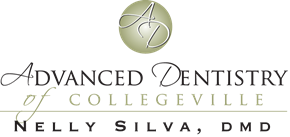Neuromuscular dentistry sounds complicated, and to be honest, it is quite involved. However, our training and tools allow us to provide neuromuscular therapies that can alleviate a long list of nagging, chronic symptoms, including:
- Migraines or Headaches
- Crowded or Loose Teeth
- Clenching and Grinding
- Wear or Notches at the Gum Line
- Pain in Shoulders, Neck, Back, Behind the Eyes, and in Teeth
- Numbness or Tingling in Extremities
- Receding Gums
- Earaches
If you suffer from one or more of these symptoms, call us today to schedule your neuromuscular exam and consultation.
How We Assess Neuromuscular Dysfunction
 Traditional dentistry addresses concerns with teeth, not muscles. However, scientific developments have revealed that some problems and pain associated with the teeth, face, and surrounding structures may be caused by improper function of muscles and nerves. The jaw position may not be affected by teeth’s position, but the reverse is not true. Teeth can be affected by improper jaw position.
Traditional dentistry addresses concerns with teeth, not muscles. However, scientific developments have revealed that some problems and pain associated with the teeth, face, and surrounding structures may be caused by improper function of muscles and nerves. The jaw position may not be affected by teeth’s position, but the reverse is not true. Teeth can be affected by improper jaw position.
K7 mandibular scanning unitOur initial step in assessing a patient for neuromuscular problems involves use of a low-frequency Transcutaneous Electrical Neural Stimulation, or TENS, unit. By delivering small electrical impulses to the muscles responsible for jaw movement, the TENS unit relaxes jaw muscles. This results in increased blood flow to flush toxins from the area. After just less than an hour, the relaxed jaw muscles find ideal positioning.
 Next, we diagnose the problem with our K-7 computerized mandibular scanning unit, which records proper alignment of the jaw and creates digital models of the teeth. With a magnet and sensor, the K-7 can develop 3D images of the patient’s jaw and mouth. The K-7 also has an elctro-myograph to measure electrical activity in the muscles. This allows us to determine whether the jaw’s ideal position decreases muscle activity. Another tool within the K-7 is a sonograph, which measures sounds in the jaw joint. This information tells us if the patient’s jaw joint is damaged and to what extent.
Next, we diagnose the problem with our K-7 computerized mandibular scanning unit, which records proper alignment of the jaw and creates digital models of the teeth. With a magnet and sensor, the K-7 can develop 3D images of the patient’s jaw and mouth. The K-7 also has an elctro-myograph to measure electrical activity in the muscles. This allows us to determine whether the jaw’s ideal position decreases muscle activity. Another tool within the K-7 is a sonograph, which measures sounds in the jaw joint. This information tells us if the patient’s jaw joint is damaged and to what extent.
Therapy Options:
If the information we gather shows that a patient has improper jaw alignment, we will begin conservative therapy by creating a custom orthotic appliance to hold the patient’s jaw in proper alignment. The patient will wear the orthotic for three months to stabilize the bite. We can then determine whether the orthotic alleviated symptoms and if further therapy is necessary. A patient may need no more therapy, or they may wear the orthotic as maintenance for the rest of his life. Orthodontics, restoration of tooth arches, or bite adjustment may also be advised.
Don’t you deserve relief?
Call Dr. Silva, Collegeville’s leading Dentist, to learn more about neuromuscular dentistry. Our dental office is located in Collegeville. We also provide dental services to the following areas: Royersford, Oaks, Limerick, Blue Bell, Skippack, Norristown, Trappe, Philadelphia, and Phoenixville. Call today to request an appointment for your assessment and consultation. (610) 489-5555
